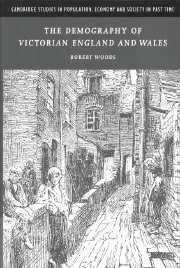Book contents
- Frontmatter
- Contents
- List of figures
- List of tables
- Preface
- 1 Bricks without straw, bones without flesh
- 2 Vital statistics
- 3 Whatever happened to the preventive check?
- 4 Family limitation
- 5 The laws of vitality
- 6 Mortality by occupation and social group
- 7 The origins of the secular decline of childhood mortality
- 8 Places and causes
- 9 The demographic consequences of urbanisation
- 10 The transformation of the English and other demographic regimes
- 11 Conclusions and unresolved conundrums
- Bibliography
- Index
- Cambridge Studies in Population, Economy and Society in Past Time
1 - Bricks without straw, bones without flesh
Published online by Cambridge University Press: 07 August 2009
- Frontmatter
- Contents
- List of figures
- List of tables
- Preface
- 1 Bricks without straw, bones without flesh
- 2 Vital statistics
- 3 Whatever happened to the preventive check?
- 4 Family limitation
- 5 The laws of vitality
- 6 Mortality by occupation and social group
- 7 The origins of the secular decline of childhood mortality
- 8 Places and causes
- 9 The demographic consequences of urbanisation
- 10 The transformation of the English and other demographic regimes
- 11 Conclusions and unresolved conundrums
- Bibliography
- Index
- Cambridge Studies in Population, Economy and Society in Past Time
Summary
Demographers are more akin to hedgehogs than foxes. They possess a particular unifying principle and relate everything to a single central vision. The foxes, on the other hand, think in a diffuse fashion: they move on many levels collecting objects and experiences without seeking to fit them into any form of all-embracing scheme. Demographers are like hedgehogs in another sense: they tend to rely on one highly effective strategy for survival against which the cunning of foxes will usually fail. The unifying principle is the notion of the demographic system and transition, while the survival strategy involves quantification within an empiricist-positivist methodology.
Although this caricature cannot do justice to the contributions of demographers, it nonetheless highlights certain important characteristics about the way questions are asked and answers attempted. Philosophical introspection is rarely indulged in and thoughts on what might be an appropriate epistemology for demography are not aired. Even among historical demographers, at least some of whom have been drawn from the ranks of history and geography where disciplinary self-doubt has been rife, there is a quiet contentment with very specific lines of enquiry in which the first step invariably involves the measurement and description of a certain set of events: birth, marriage, death, migration. This is usually followed by the search for some form of demographic order, pattern recognition and modelling. Finally, explanation or interpretation is attempted although this may take many forms varying from formal hypothesis testing to ‘thick description’.
- Type
- Chapter
- Information
- The Demography of Victorian England and Wales , pp. 1 - 30Publisher: Cambridge University PressPrint publication year: 2000



